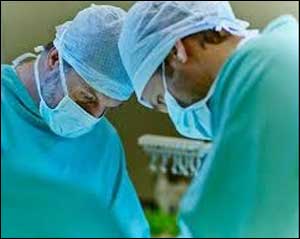- Home
- Editorial
- News
- Practice Guidelines
- Anesthesiology Guidelines
- Cancer Guidelines
- Cardiac Sciences Guidelines
- Critical Care Guidelines
- Dentistry Guidelines
- Dermatology Guidelines
- Diabetes and Endo Guidelines
- Diagnostics Guidelines
- ENT Guidelines
- Featured Practice Guidelines
- Gastroenterology Guidelines
- Geriatrics Guidelines
- Medicine Guidelines
- Nephrology Guidelines
- Neurosciences Guidelines
- Obs and Gynae Guidelines
- Ophthalmology Guidelines
- Orthopaedics Guidelines
- Paediatrics Guidelines
- Psychiatry Guidelines
- Pulmonology Guidelines
- Radiology Guidelines
- Surgery Guidelines
- Urology Guidelines
AIIMS doctors remove two-inch sewing needle from a 10 years girl's back

A team of doctors at the All India Institute of Medical Sciences (AIIMS) has successfully removed a two-inch sewing needle from the back of a 10-year-old girl that was left behind by her mother on a bed at home.
The matter was taken lightly by parents in the beginning, although the girl complained that something had pierced into her back as she experienced severe pain.
She was rushed to the nearby Chacha Nehru Bal Chikitsalaya, where an X-ray revealed a foreign object, which the parents identified as the needle which got embedded in her back, Dr Shilpa Sharma, a pediatric surgeon at AIIMS said.
Surgery was performed there to remove it, but unfortunately the needle could not be traced during the surgery, the doctor said. As the pain got worse, the girl was referred to the All India Institute of Medical Sciences Trauma Centre.
"The X-ray showed the needle in the back muscles. We decided to wait so that it becomes fixed to the surrounding tissue and does not move during surgery."
"We waited for two weeks and meanwhile the kid was under regular observation to ensure that the needle is still intact and in the same place. The risks included dislocation of the needle into any vital organ or vessel. It was very near the spinal canal but luckily there was no damage. An ultrasound was done to monitor the needle instead of repeated X-rays to avoid radiation to the child," Sharma explained.
The girl was operated on August 30. With palpation, the needle was traced deep inside. It was more than one-inch deep at the level of the spine bone on the left side, she said.
"A special needle with markings was used to feel the needle. The needle had rusted inside the body and was friable. The eye (of the needle) broke on touching. Luckily, the lower part of the needle was also in the grip and it was slide out carefully. There was no complication and the girl was discharged after a few hours," Dr Gyanendra Singh, neuro anesthetists, said.
The girl is fine now and is able to carry out her day-to-day activities, Dr Sharma said.
She advised her parents to be careful with such items while doing their daily chores and also teach their children to take care of their surroundings.
AIIMSAIIMS doctorsAIIMS newsAll India Institute of Medical SciencesChacha Nehru Bal ChikitsalayaMedical newsmedical news indiaPainsewing needlespinal canalspine bonesurgeryTrauma CentreUltrasoundX ray
Next Story
NO DATA FOUND

Disclaimer: This site is primarily intended for healthcare professionals. Any content/information on this website does not replace the advice of medical and/or health professionals and should not be construed as medical/diagnostic advice/endorsement or prescription. Use of this site is subject to our terms of use, privacy policy, advertisement policy. © 2020 Minerva Medical Treatment Pvt Ltd